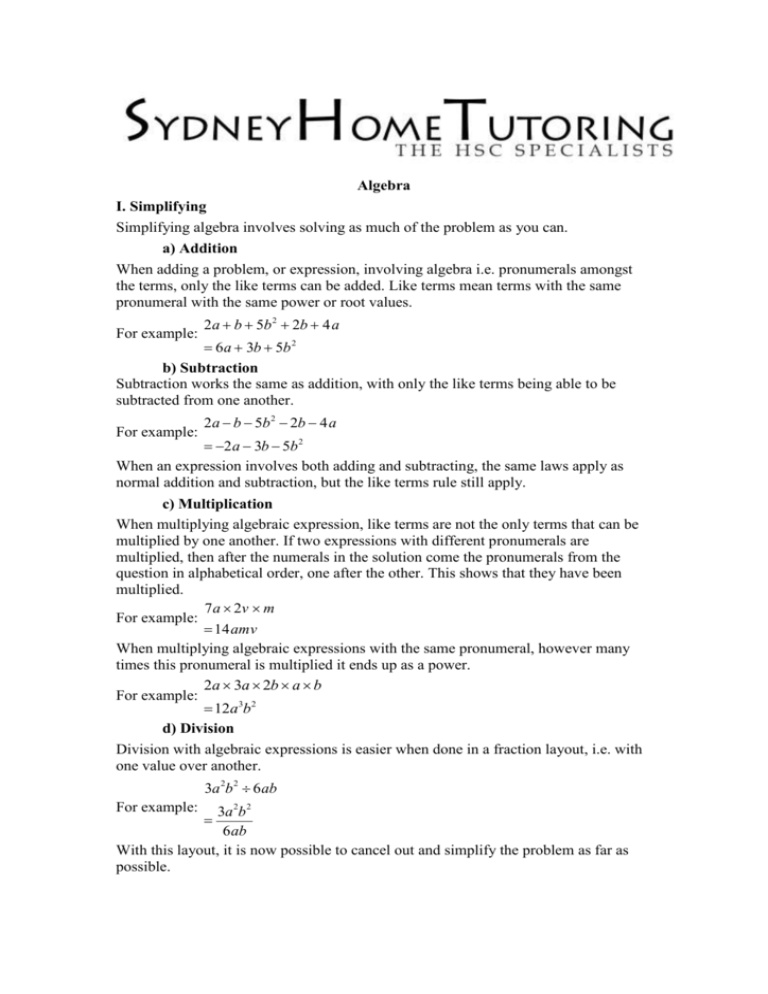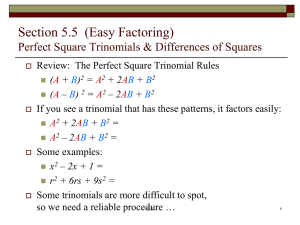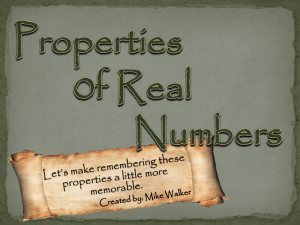Algebra - Sydney Home Tutoring
advertisement

Algebra I. Simplifying Simplifying algebra involves solving as much of the problem as you can. a) Addition When adding a problem, or expression, involving algebra i.e. pronumerals amongst the terms, only the like terms can be added. Like terms mean terms with the same pronumeral with the same power or root values. For example: 2a b 5b 2 2b 4a 6a 3b 5b 2 b) Subtraction Subtraction works the same as addition, with only the like terms being able to be subtracted from one another. For example: 2a b 5b 2 2b 4a 2a 3b 5b 2 When an expression involves both adding and subtracting, the same laws apply as normal addition and subtraction, but the like terms rule still apply. c) Multiplication When multiplying algebraic expression, like terms are not the only terms that can be multiplied by one another. If two expressions with different pronumerals are multiplied, then after the numerals in the solution come the pronumerals from the question in alphabetical order, one after the other. This shows that they have been multiplied. 7a 2v m For example: 14amv When multiplying algebraic expressions with the same pronumeral, however many times this pronumeral is multiplied it ends up as a power. 2a 3a 2b a b For example: 12a3b2 d) Division Division with algebraic expressions is easier when done in a fraction layout, i.e. with one value over another. 3a 2b 2 6ab For example: 3a 2b 2 6ab With this layout, it is now possible to cancel out and simplify the problem as far as possible. 3a 2b 2 6ab 3 a a b b 6ab ab 2 This solution is found because 3 and 6 cancel to give 1 and 2, and the a and b on the bottom cancelled one a and one b on top, leaving one of each. II. Factorisation Factorization is the resolution of number/s into factors so that when multiplied together they give those number/s. a) Simple Simple factorisation involves expressions that have the common factor outside of the brackets containing the numbers that have had the common factor taken out of them To factorise a simple expression, the distributive law: ax bx x(a b) . Example: x 2 2x x(x 2) because the common factor is x. And: 6a2b3 3a3b2 3a2b2 (2b a) similarly. b) Grouping in pairs When an expression has for terms, then it can be factorised into pairs. The standard ax bx ay by form for this is x(a b) y(a b) . (a b)(x y) 2x 4 6y 3xy 2(x 2) 3y(x 2) Example: 2(x 2) 3y(x 2) (x 2)(2 3y) c) Mixed Mixed factors are where an expression needs more then one method of factorising to complete it. They are case specific with combinations of the methods above. 24 3b 3 3(8 b 3 ) Example: This uses simple factors and the difference of 2 3(2 b)(4 2b b2) cubes. d) Trinomials A trinomial is an expression with three terms. Factorising one usually gives a binomial product. The standard form for a trinomial is x 2 (a b)x ab x 2 ax bx ab x(x a) b(x a) (x a)(x b) . x 2 5x 24 x 2 8x 3x 24 Example: x(x 8) 3(x 8) because a in the standard form is –8 here, (x 8)(x 3) and b in standard form is 3. e) Perfect squares Perfect squares are the factorising of binomial products to get grouping in pairs, except that the pairs are the same so that they can be displayed as one expression in brackets and squared. The standard from for perfect squares are a2 2ab b2 (a b)2 and a2 2ab b2 (a b)2 . Example: 4x 2 12x 9 (2x 3)2 p2 2 5p 5 (p 5) f) Difference of 2 squares The standard form for the difference of 2 squares is a2 b2 (a b)(a b) . Example: 4a 2 3 (2a 3)(2a 3) g) Sum of 2 cubes a3 b3 (a b)(a2 ab b2 ) . Here, the The standard form for the sum of 2 cubes is acronym of S.O.P.S can be applied, which stands for square of first pronumeral, opposite sign between pronumerals, both pronumerals together and then square of the last pronumeral. Example 8 27y 3 (2 3y)(3 6y 9y 2 ) h) Difference of 2 cubes The standard form for the difference of 2 cubes is a3 b3 (a b)(a2 ab b2 ) . Once again, S.O.P.S can be applied. Example: a3b3 1 (ab 1)(a2b2 ab 1) and 2 8(a 3) 3 b 3 (2a 6 b)(4a 2 12a 12a 36 2ab 6b b ) because the first (2a 6 b)(4a 2 24a 2ab 6b b 2 36) cube root, 2a+6, is one expression and must be square out as the whole thing, like a binomial product. III. Expansion Expansion is the process of removing grouping symbols, such as brackets or parentheses, so that the expression can be seen in it whole form. a) Simple Simple expansion involves the use of the distributive law a(b c) ab ac . This removes the brackets and keeps the expression true. 4 3(a 5) (a 7) 4 3a 15 a 7 Example: 2(4 y 3) 8y 6 and 28 2a b) Binomials Binomials refer to two numbers, but in reference to expansion we refer to binomial products, with two binomials been multiplied together. i) Simple Simple binomials involve the two terms in the first bracket being multiplied by the two terms in the second brackets. The standard form for simple binomials is (a b)(x y) ax ay bx by . Example: (2y 3)(y 5) 2y 2 10y 3y 15 2y 2 7y 15 ii) Perfect squares When some binomial products are expanded, we can see that they have special properties that are used in other areas and that they can be expanded or factorised quickly. Perfect squares, in reference to expansion, are binomial products have the same expressions multiplied by one another, i.e. one binomial squared. Their standard form is (a b)2 a2 2ab b2 and (a b)2 a2 2ab b2 . Example: (t 4)2 t 2 8t 16 and (3y 1) 2 9y 2 6y 1 IV. Other Algebra functions There are other uses for algebra, which can be seen below. a) Substitution Algebra is used in formulae so that when measurements are taken the pronumerals can be substituted for real numbers. Some formulae included finding the area of a 1 triangle A bh , where A = area, b= base and h= height. When measurements are 2 found for b and h, the area of the triangle can be found. b) Algebraic Fractions Algebraic fractions involve expressions with known and unknown denominators and the four operations (addition, subtraction, multiplication and division). When there is a known denominator, the fractions are simplified the same way as ordinary fractions. When an unknown denominator is present and multiplication or division is required, they are also done the same way as ordinary fractions. When an unknown denominator is present and addition or subtraction is needed, then the same thing can be done as with normal fractions, that is, finding the lowest common denominator. This usually finds a binomial product or other algebraic expressions before the addition and subtraction is done. All different scenarios have examples below. x 1 x 3 5 4 4 x 4 5x 15 2a 2 10ab a 2 25 b 3 27 4b 12 20 x 19 20 c)Completing the square Completing the square is a method derived from a perfect square. The general form when factorising a perfect square is a2 2ab b2 (a b)2 . When given an expression in the form of a 2 pa, we can complete the square by p p halving p and squaring it. Thus it gives a 2 pa ( ) 2 . Since p 2b, b and 2 2 p to give a perfect square and another number (unless b2 ( )2 . This can be factorised 2 it is a quadratic equation.







